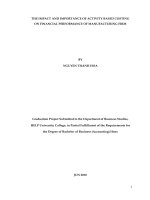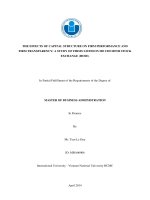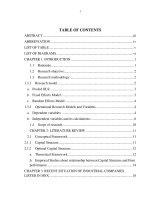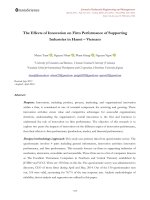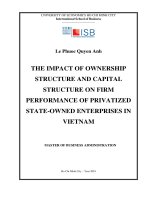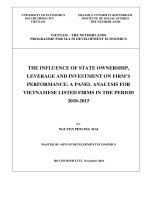Knowledge Management and Innovation on Firm Performance of United
Bạn đang xem bản rút gọn của tài liệu. Xem và tải ngay bản đầy đủ của tài liệu tại đây (1.28 MB, 126 trang )
Walden University
ScholarWorks
Walden Dissertations and Doctoral Studies
Walden Dissertations and Doctoral Studies
Collection
2016
Knowledge Management and Innovation on Firm
Performance of United States Ship Repair
Cynthia Jane Young
Walden University
Follow this and additional works at: />Part of the Business Commons
This Dissertation is brought to you for free and open access by the Walden Dissertations and Doctoral Studies Collection at ScholarWorks. It has been
accepted for inclusion in Walden Dissertations and Doctoral Studies by an authorized administrator of ScholarWorks. For more information, please
contact
Walden University
College of Management and Technology
This is to certify that the doctoral study by
Cynthia Young
has been found to be complete and satisfactory in all respects,
and that any and all revisions required by
the review committee have been made.
Review Committee
Dr. Michael Lavelle, Committee Chairperson, Doctor of Business Administration Faculty
Dr. Richard Johnson, Committee Member, Doctor of Business Administration Faculty
Dr. Peter Anthony, University Reviewer, Doctor of Business Administration Faculty
Chief Academic Officer
Eric Riedel, Ph.D.
Walden University
2016
Abstract
Knowledge Management and Innovation on Firm Performance of United States Ship
Repair
by
Cynthia J. Young
MBA, Touro University International, 2007
MBA, Touro University International, 2003
BA, University of Maryland, College Park, 1997
Doctoral Study Submitted in Partial Fulfillment
of the Requirements for the Degree of
Doctor of Business Administration
Walden University
March 2016
Abstract
With the decreasing labor forces throughout the United States, if leadership of the ship
repair industry does not incorporate knowledge sharing and innovation into their daily
business practices, knowledge will be lost during employee departures and turnover of
teams from project-to-project, resulting in decreasing firm performance within their
organizations. This was a correlation study to determine if there was a correlation
between knowledge management, innovation, and firm performance. Data were collected
from 69 CEO/Presidents, Human Resource personnel, or members in leadership positions
of the Virginia Ship Repair Association in the mid-Atlantic region of the United States.
The theoretical framework for this study was the unified model of dynamic knowledge
creation with the key constructs of the socialization, externalization, combination, and
internalization process; places of knowledge sharing, whether they are virtual, physical,
or mental; and leadership. Data collection occurred through an online survey. Multiple
linear regression analyses significantly predicted the dependent variable, F(2, 66) =
17.33, p = .000, R2 = .344. Increasing knowledge sharing and innovation practices
provides for positive social change for the personnel of these organizations, since the
skills they learn within their organizations are immediately usable in their personal
endeavors in their churches, neighborhoods, and family relationships and are
transferrable to those they interact with outside of their organizations.
Knowledge Management and Innovation on Firm Performance of United States Ship
Repair
by
Cynthia J. Young
MBA, Touro University International, 2007
MBA, Touro University International, 2003
BA, University of Maryland, College Park, 1997
Doctoral Study Submitted in Partial Fulfillment
of the Requirements for the Degree of
Doctor of Business Administration
Walden University
March 2016
Dedication
Words do not seem adequate for this enough for this magnitude of a sacrifice by
my husband and my daughter. I dedicate this to my loving husband, James Young, and
my amazing daughter, Megan Butler. Without their support and sacrifice of time, I would
have never gotten past the coursework stages of this endeavor and would have always
regretted not finishing this doctoral study. I can only hope they understand that I really
could not have done it without them.
I love you both and I can only hope you find me as supportive of your goals as I
have found you supportive of mine.
Acknowledgments
Thank you, again, to my husband, James Young, and my daughter, Megan Butler,
for their support of my educational goals and for believing in me.
Thank you to my best friend, Fallon Morey, who has stood beside me throughout
this study and has forgiven me for being distracted by it while listening to me kvetch
about it over many cups of coffee.
Thank you to my cohorts who have supported me and have allowed me to support
them which increased the overall knowledge of this process. I truly appreciate our shared
texts and phone calls that started following our residencies and are still occurring
regularly. I would not be here without you. The comradery and the knowledge sharing
throughout this process has been priceless.
Finally, thank you to my two Chairs. Dr. Maureen Steinwall got me off on a great
start with her “Big Six” and ensuring I focused on my alignment. Dr. Michael Lavelle, or
Dr. Mike, helped me to not lose sight of the finish line and provided forceful backup
when needed while helping me to achieve my ultimate educational goal. I appreciate the
faith you had in me and the forceful backup you both provided.
Table of Contents
List of Tables ..................................................................................................................... iv
List of Figures ......................................................................................................................v
Section 1: Foundation of the Study......................................................................................1
Background of the Problem ...........................................................................................1
Problem Statement .........................................................................................................2
Purpose Statement ..........................................................................................................3
Nature of the Study ........................................................................................................3
Research Question .........................................................................................................4
Hypotheses .....................................................................................................................4
Theoretical Framework ..................................................................................................5
Definition of Terms........................................................................................................6
Assumptions, Limitations, and Delimitations ................................................................6
Assumptions............................................................................................................ 7
Limitations .............................................................................................................. 7
Delimitations ........................................................................................................... 8
Significance of the Study ...............................................................................................8
Contribution to Business Practice ........................................................................... 9
Implications for Social Change ............................................................................... 9
A Review of the Professional and Academic Literature ..............................................10
Theoretical Frameworks ....................................................................................... 12
Learning Organizations ......................................................................................... 15
i
Knowledge Management ...................................................................................... 19
Leadership ............................................................................................................. 26
Innovation Culture ................................................................................................ 28
Employee Turnover .............................................................................................. 34
Firm Performance ................................................................................................. 39
Transition and Summary ..............................................................................................41
Section 2: The Project ........................................................................................................43
Purpose Statement ........................................................................................................43
Role of the Researcher .................................................................................................44
Participants ...................................................................................................................45
Research Method and Design ......................................................................................46
Research Method .................................................................................................. 46
Research Design.................................................................................................... 47
Population and Sampling .............................................................................................48
Ethical Research...........................................................................................................50
Data Collection Instrument ..........................................................................................51
Strategic Knowledge Management, Innovation, and Performance
Questionnaire ............................................................................................ 51
Data Collection Technique ..........................................................................................54
Data Analysis ...............................................................................................................55
Testing of Assumptions ........................................................................................ 56
Study Validity ..............................................................................................................59
ii
Transition and Summary ..............................................................................................61
Section 3: Application to Professional Practice and Implications for Change ..................63
Introduction ..................................................................................................................63
Presentation of the Findings.........................................................................................65
Discussion of the Findings .................................................................................... 68
Applications to Professional Practice ..........................................................................69
Implications for Social Change ....................................................................................71
Recommendations for Action ......................................................................................72
Recommendations for Further Research ......................................................................73
Reflections ...................................................................................................................75
Summary and Study Conclusions ................................................................................75
References ..........................................................................................................................77
Appendix A: Letter of Cooperation .................................................................................100
Appendix B: Consent Form .............................................................................................101
Appendix C: National Institutes of Health Certificate of Completion ............................103
Appendix D: Sample of Instrument .................................................................................104
Appendix E: PsycTests Documentation...........................................................................106
Appendix F: Email to Questionnaire Authors .................................................................107
Appendix G: License Agreement.....................................................................................108
iii
List of Tables
Table 1. Source Material ....................................................................................................11
Table 2. Multicollinearity of Knowledge Management and Innovation ............................58
Table 3. Means of Knowledge Management Survey Reponses (n = 69)...........................64
Table 4. Means of Innovation Survey Responses (n = 69) ................................................64
Table 5. Means of Firm Performance Survey Responses (n = 69) ....................................65
Table 6. Descriptive Statistics (n = 69)..............................................................................66
Table 7. Model Summary with Dependent Variable of Firm Performance .......................66
Table 8. Analysis of Variance ............................................................................................67
Table 9. Coefficients of Knowledge Management and Innovation ...................................67
Table 10. Bootstraps for Coefficients of Knowledge Management and Innovation .........68
iv
List of Figures
Figure 1. Power as a function of sample size.................................................................... 49
Figure 2. Normal P-P plot of regression standardized residual: Dependent variable: Firm
performance. ............................................................................................................. 56
Figure 3. Histogram of regression standardized residual: Dependent variable: Firm
performance. ............................................................................................................. 57
Figure 4. Test for linearity. ............................................................................................... 57
Figure 5. Test results for homoscedasticity: Dependent variable: Firm Performance. ..... 59
v
1
Section 1: Foundation of the Study
Within any organization there may be a learning curve where knowledge
management and innovation practices can make a difference in the success or failure of
the organization. A strong performance of a ship repair organization within the East
Coast ship repair industry is necessary since these organizations conduct maintenance on
45 United States Navy East Coast surface ships (Navy Chief of Information, 2015). The
U.S. shipbuilding and ship repair industry operates shipyards to include ship construction,
repair, conversion, alteration, and other specialized services (Maritime Administration,
2013). Forty of the 45 East Coast surface ships in the U.S. Navy receive maintenance in
the mid-Atlantic region (Navy Chief of Information, 2015). These vessels have different
configurations that have different maintenance and repair requirements within their own
learning curves (Navy Chief of Information, 2015). In this study, I wanted to see if the
variables of knowledge management and innovation positively related to firm
performance.
Background of the Problem
Much of the corporate knowledge sharing throughout an organization occurs
through employee communication. Since 1992 there has been a reduction within the U.S.
labor force creating a potential lack of continuity of knowledge flow (Bureau of Labor
Statistics, 2014, para. 3). Lack of continuity and management of knowledge affects the
ability of an organization to attain or maintain positive firm performance. Additionally,
innovation was another aspect of knowledge flow that may affect firm performance. This
is a strong potential problem in the U.S. ship repair industry.
2
The problem of knowledge transfer and firm performance has attracted significant
study. Through a multimethods study of surveys and an in-depth case study, Chang and
Chuang (2011) studied how knowledge management processes of infrastructure
capability and business strategy affected firm performance. Cheng and Huang (2012)
determined knowledge management strategy, information technology, and human
resource management strategies may be linked to firm performance based on growth and
profitability. Researchers have examined firm performance as affected by
knowledge transfer (Arnett & Wittman, 2014),
knowledge sharing and innovation (Wang & Wang, 2012), and
employee mobility and entrepreneurship (Alegre & Chiva, 2013; Campbell,
Ganco, Franco, & Agarwal, 2012).
In a study regarding knowledge conversion processes, externalization (tacit-toexplicit) was the only factor that did not show a positive influence on a learning
organization (Al-adaileh, Dahou, & Hacini, 2012). Hung and Chou (2013) examined firm
performance as affected by open innovation and moderated by the effects of internal
research and development, and environmental turbulence. These studies support the need
for knowledge management and innovation in support of positive firm performance.
Problem Statement
The largest concentration of the U.S. labor force consists of workers aged 25 to 54
years, who represented 71.4% of the labor force in 1992 and decreased to 65.3% in 2012
(Bureau of Labor Statistics, 2014, para. 3). Based on projections, by 2022, the 25 to 54
age group will continue declining to comprise 63.1% of the total labor force (Bureau of
3
Labor Statistics, 2014, para. 3). The general business problem was that some ship repair
managers may not know how to ensure knowledge management and innovation practices
in their organizations to support firm performance. The specific business problem is that
knowledge management, innovation, and firm performance are important to businesses,
but it is unclear whether ship repair managers in the mid-Atlantic region of the East Coast
understand this relationship.
Purpose Statement
The purpose of this quantitative correlation study was to examine the relationship
between knowledge management, innovation, and firm performance in the U.S. ship
repair industry. The independent variables were knowledge management and innovation
and the dependent variable was firm performance. The targeted population consisted of
members from 253 organizations of the Virginia Ship Repair Association (VSRA) in the
mid-Atlantic, Tidewater region. This population was especially appropriate for studying
this topic because Virginia had the largest percent of U.S. private employment in the
shipbuilding and ship repair industry at 24.9%, which was significantly more than the
closest competing state (12.9%) (Maritime Administration, 2013). This study promoted
positive social change by improving organizational knowledge management and
innovative practices to counter employee turnover while continuing to execute an
organization’s strategic plans.
Nature of the Study
The quantitative survey methodology was the most appropriate methodology for
this study since it was objective, deductive, and tested a theory (Bryman & Bell, 2011).
4
The qualitative approach was not appropriate because in a qualitative study a researcher
interprets the information gathered to generate a theory (Bryman & Bell, 2011). Based on
the above descriptions, a mixed methods approach was also inappropriate because of the
incorporation of a qualitative study component.
For the study’s design, the intention was to use the correlation design. This design
was best for this study since the correlation design is an approach to analyzing
relationships between variables for strength and direction (Bryman & Bell, 2011). In this
study, I analyzed the strength and directional relationship between knowledge
management and organizational innovation culture on firm performance. A case study
design was not appropriate since it supports an examination of a single organization
rather than a large group of organizations (Bryman & Bell, 2011). An experimental
design was also inappropriate since the participants of were not exposed to treatments in
this study (Charness, Gneezy, & Kuhn, 2012). The correlation study allowed for
examination of the research question in order to determine the relationship between the
variables.
Research Question
The research question for this quantitative correlation study was what is the
relationship between knowledge management, innovation, and firm performance?
Hypotheses
Ho: There is no relationship between knowledge management, innovation, and
firm performance.
5
Ha: There is a statistically significant relationship between knowledge
management, innovation, and firm performance.
Theoretical Framework
The theoretical framework for this study was the unified model of dynamic
knowledge creation by Nonaka, Toyama, and Konno (2000). This model was an
extension of the dynamic theory of organizational knowledge creation (Nonaka, 1994).
Von Krogh, Nonaka, and Rechsteiner (2012) surmised organizational learning is a
continuous dialogue and that for knowledge to be articulated, knowledge creation should
be fundamental to organizational processes. Key constructs underlying the theoretical
framework of the unified model of dynamic knowledge creation are: (a) the socialization,
externalization, combination, and internalization (SECI) process, (b) ba, a physical,
mental, or virtual place where shared interactions occur (Von Krogh, Nonaka, &
Rechsteiner, 2012), and (c) leadership (Nonaka et al., 2000). The key constructs of the
dynamic theory of organizational knowledge creation were analogous with the key
constructs of this study.
As applied to this study, I expected the independent variables (a) SECI, (b) ba,
and (c) leadership (Nonaka et al., 2000), measured by the Strategic Knowledge
Management, Innovation, and Performance Questionnaire (López-Nicolás & MeroCerdán, 2011), would support the influence of knowledge management and innovation on
firm performance. Based on a sampling of available literature, firm performance
measures were primarily financial-based outcomes (Delen, Kuzey, & Uyar, 2013; Singh,
Darwish, Costa & Anderson, 2012; Wang & Wang, 2012). In addition to financial
6
measures, Singh et al.’s (2012) performance measures for organization performance
included human resource-oriented factors such as employee turnover and other outcomes
from productive and quality. This theoretical framework was appropriate since without
forward thinking leadership, knowledge creation, innovative practices, and growth may
remain stagnant while negatively affect firm performance (Nonaka et al., 2000).
Definition of Terms
Ba: Ba is a mental, virtual, or physical space where knowledge creation occurs
from information interpretation (Nonaka et al., 2000).
Explicit knowledge: Explicit knowledge is the knowledge which can be shared
through formal and systematic processes (Nonaka et al., 2000), or knowledge specifically
related to an industry (Gilson, Lim, Luciano, & Choi, 2013).
Tacit knowledge: Tacit knowledge is knowledge that is difficult to formalize since
it is personal knowledge gained through experience, action, or involvement (Nonaka,
1994).
Assumptions, Limitations, and Delimitations
Assumptions are ideas not specifically expressed, but are theoretical points
considered by researchers based on how the world is presently (Martin & Parmar, 2012).
Study limitations are facets of the study that a research cannot control or change.
Delimitations are choices or restrictions for this study made at the onset of the study. The
following assumptions, limitations, and delimitations set the tone for this study.
7
Assumptions
An assumption in social science is how researchers should conduct examinations,
such as the choice of a methodology (Punch, 2014). For a satisfactory survey response,
the first assumption was that the VSRA President would continue supporting this study
and associated survey as agreed to within the terms of the signed Letter of Cooperation
(Appendix A). The second assumption was that the email list of requested participants
would be up to date, accurate, and complete. The third assumption was that the invited
participants would not forward their unique survey link to someone not intended to
receive the survey. The fourth assumption was that if someone did receive a survey link
that should not have that any unintended recipients would not respond to the survey. The
fifth assumption was that none of the respondents knew me outside of my professional
life and did not have a personal relationship with me. The final assumption was that any
participants who completed the survey would respond honestly to all of the survey
questions.
Limitations
A limitation may be that in a correlation study, there is not a way to determine the
cause of a change in the dependent variable (Mitchell & Jolley, 2010). One limitation was
that the selected participants would respond since they did not know me on a personal
level. Another potential limitation was that the respondents might not be aware that their
companies are supporting knowledge management practices and respond that their
companies did not support knowledge management practices providing false results.
False results were also possible with the survey questions about innovation and firm
8
performance. A final limitation was that this study examined the perspective of the ship
repair community within the mid-Atlantic region of Virginia and therefore, was not
generalizable outside of the mid-Atlantic region.
Delimitations
In order to reduce the scope of a study, delimitations are self-imposed restrictions
by the researcher (Rovai, Baker, & Ponton, 2014). Requested participants of the ship
repair organizations were within the Hampton Roads area of the mid-Atlantic region in
order to establish the geographic boundaries of this study. Specifically, the invited
participants were managers of the organizational executives as well as human resources
and operations department management. Additionally, the survey had Likert scale
response selections for managing data and removing the ambiguity that was possible with
open-ended responses.
Significance of the Study
The significance of this study was helping organizations justify the organizational
investment in capturing knowledge and innovation since this could support firm
performance improvements across an organization. The intention was to examine
organizational knowledge management and organizational innovation culture to ascertain
their relationship with firm performance. This study addressed the expectation that
organizational knowledge management and organizational innovation have a positive
influence on firm performance. In this study, firm performance was the perceived growth
of organizational practices and process improvements as viewed by the CEO/Presidents,
9
Human Resource, or members in leadership positions in relation to their competing
organizations.
Contribution to Business Practice
The primary contribution to business practices was through recognition of
opportunities where managing organizational knowledge and innovative practices
improve firm performance even in response to employee turnover. I created this study to
fill gaps in the understanding and effective practices of how knowledge management and
innovation support positive firm performance. Although this study’s sample was from a
population of Virginia Ship Repair Association members, this study was generalizable
outside of the ship repair industry to provide organizations insight on organizational
knowledge management tools and processes.
This study’s value to business was to improve an organization internally, as well
as to support a better product or service to their customers and other external
stakeholders. It contributed to the active practice of business because it provided
justification to management to invest in the use of knowledge management processes and
expose the organization to innovative practices that may improve their firm performance.
With these investments and improvements, an organization’s support to social change in
the venue of personal and professional growth of their workforce organization-wide and
provides better support to their customers as their internal processes improve.
Implications for Social Change
As stated earlier, the implication for positive social change is that organizational
management would encourage knowledge management and innovation, which in turn
10
would promote professional development of the workforce. Employee empowerment
would become part of an organization’s innovative culture. Organizational leadership has
the responsibility and accountability of ensuring their innovative practices are ethical and
do not subject their workforce to unnecessary distress or force them into unethical
practices (Weisenfeld, 2012). Within the realm of social change, organizational
leadership can also use innovation to improve the livelihood of their employees as well as
their stakeholder knowledge sharing via online communities (Von Krogh, 2012). This
study provided empirical rationalization for exploring knowledge management processes
and innovation as related to firm performance since there were positive social
implications.
A Review of the Professional and Academic Literature
The organization of the review of the professional and academic literature began
with the review of the theoretical framework. The literature review continued with a
discussion of learning organizations broken down into communities of practice, virtual
communities, and other practice-based research. I defined and related the independent
variables, knowledge management and innovation, and the dependent variable, firm
performance, to the theoretical framework of the unified model of dynamic knowledge
creation (Nonaka, 1994).
The search for professional and academic literature included the use of several
databases to include Google Scholar, EBSCO, ABI/INFORM, Business Source
Complete, and Academic Search Complete. I used peer-reviewed journal articles from
2012 through 2016 to support the requirement for at least 85% of the total sources that
11
are within 5 years of my expected graduation in 2016. Using Ulrich’s Periodical
Dictionary, I validated the peer-reviewed status of the sources ensuring at least 85% of
the total sources were peer-reviewed with a minimum of 60 peer-reviewed sources in the
literature review. Source material also reflected government websites and several
textbooks.
After evaluating over 300 references, the total number of references in this study
was 154. The total number of peer-reviewed references was 146. The total percentage of
peer-reviewed references was 94.8%. The total number of peer-reviewed references that
were 5 or fewer years old in anticipation of the Chief Academic Officer’s approval in
2016 was 132. The total percentage of peer-reviewed references in anticipation of the
Chief Academic Officer’s approval in 2016 was 85.7%. The source material breakdown
within the literature review 5 year range and outside of the literature review 5 year range
is in Table 1.
Table 1
Source Material
Sources
Peer-reviewed
journal articles
Government websites
Books
Total sources by year
grouping
Outside of 5 year
range (2011 and
earlier)
Within 5 year
range (20122016)
Total of all
sources
14
1
2
132
3
2
146
4
4
17
137
154
12
Theoretical Frameworks
After scrutinizing several theoretical frameworks that could support this study,
one theoretical framework stood out as conclusively best suited for this study. The first
theoretical framework for review was the organizational learning theory (Argote &
Miron-Spector, 2011). The second theoretical framework for review was the framework
of learning orientation as supported by firm innovation quality and performance
(Calantone, Cavusgil, & Zhao, 2002). The final theoretical framework, which was the
theoretical framework that best fit this study, was the unified model of dynamic
knowledge creation (Nonaka et al., 2000).
Theoretical framework for analyzing organizational learning. The theoretical
framework for analyzing organizational learning involved the environmental context
surrounding the latent organizational context as part of the cycle of task performance
experience leading to knowledge creation (Argote & Miron-Spector, 2011). The
organizational learning theory was a theory started through an interest in organizational
learning and knowledge as necessary to both organizational performance and success
(Argote & Miron-Spector, 2011). Garcia-Morales, Jimenez-Barrionuevo, and GutierrezGutierrez (2012) further defined this as the process where the individuals of the
organization improve an organization’s knowledge system. While this theoretical
framework addressed employee turnover and knowledge retention, it was not appropriate
since it did not identify a place where knowledge creation occurred nor innovation as
fundamental constructs (Argote & Miron-Spector, 2011).
13
Theoretical framework of learning orientation, innovation, and performance.
The learning orientation with innovation capability and firm performance as supports for
learning commitments and an ability to share vision, open-mindedness, and
intraorganizational knowledge was the second framework considered (Calantone et al.,
2002). These factors were learning orientation fundamentals supporting firm
innovativeness and performance to account for the organizational age effects (Calantone
et al., 2002). Calantone, Cavusgil, and Zhao (2002) defined learning orientation as
supporting knowledge creation at an organization-wide level, which was also essential for
organizational innovation and firm performance. This model had both knowledge
creation and knowledge sharing within the framework, but was not suitable since it did
not specify tacit or explicit knowledge transfer practices for the full breadth of knowledge
sharing. Additionally, this framework was not suitable because age was not a
consideration as a variable for this study.
Unified model of dynamic knowledge creation. The unified model of dynamic
knowledge creation best addressed this organizational challenge and required continuous
work and leadership to maintain and improve organizational knowledge (Nonaka, 1994;
Nonaka et al., 2000). With this model, knowledge creation was at the foundation of an
organization’s success and with that, knowledge sharing and transfer must occur
(Nonaka, 1994). Knowledge creation occurs as the interaction between tacit and explicit
knowledge churns through the SECI process (Nonaka, 1994; Nonaka et al., 2000). This
theory was the most appropriate framework for this study since it addressed knowledge
creation as it works with organizational changes in a dynamic environment (Nonaka,
